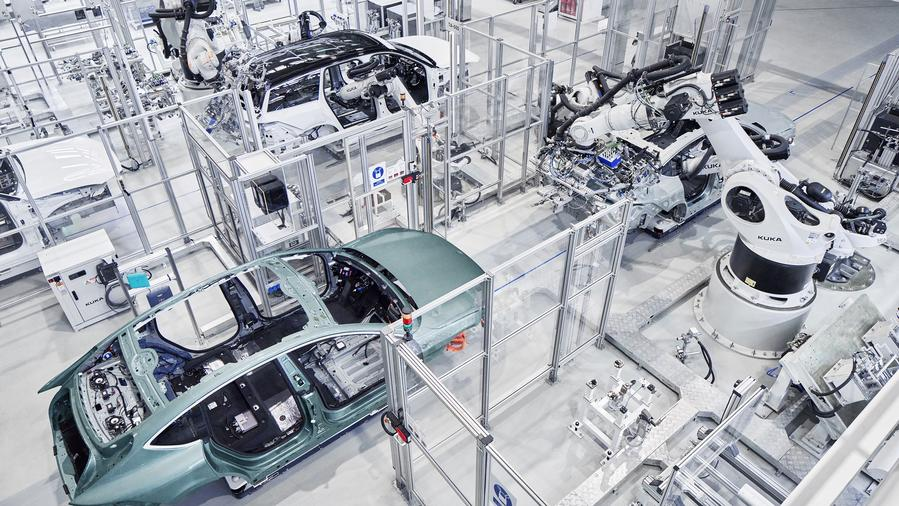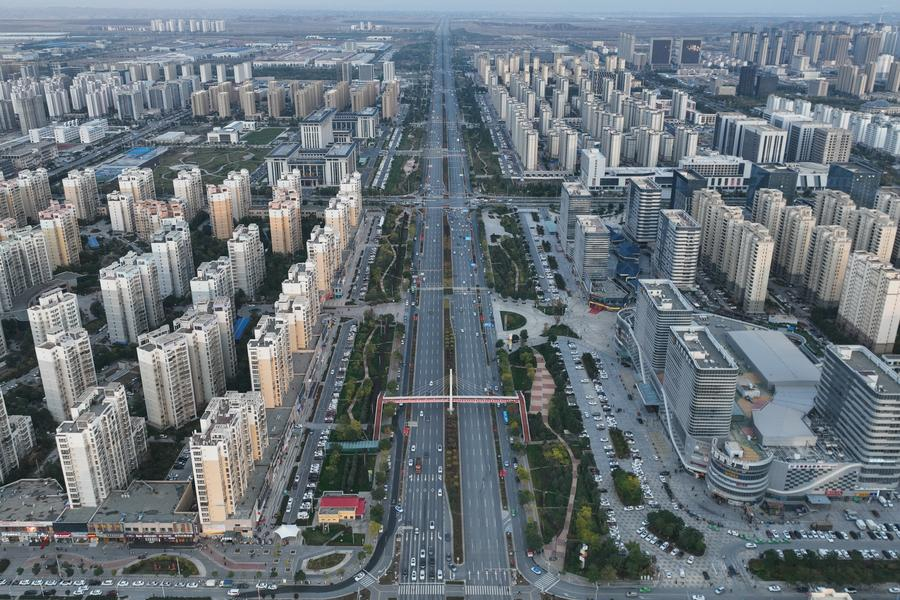Editor's note: CGTN's First Voice provides instant commentary on breaking stories. The column clarifies emerging issues and better defines the news agenda, offering a Chinese perspective on the latest global events.
During recent years, a slew of media outlets, think tanks and commentators in the West have directed intense focus and attention to the state of China's economy. Countless articles adorned with dramatic headlines have asserted the inevitability of the country's economic decline and heralded its impending demise.
Setting aside the alarmism and fear-mongering rhetoric, however, a sober, more balanced appraisal of China's broader economic realities suggests that the prevailing pessimism and bleak narrative proclaiming China's economic downturn are largely exaggerated and lack critical nuance.
Putting things into context
First, as with so many things, context is enlightening. Since China began to open up and reform its economy just over four decades ago, it has undergone an unparalleled transformation. The country's GDP growth has averaged over 9 percent annually and 800 million people were lifted out of extreme poverty. Steadily, China has risen from a poor, closed and primarily agrarian society to the second-largest economy in the world. When measured in terms of purchasing power parity, it is the largest by a considerable margin.
Alongside its implementation of economic reforms and opening-up, which were major drivers for growth via foreign and private sector investment and trade, factors such as industrialization, urbanization, demographics and globalization have helped China achieve one of the most impressive growth miracles in modern history.
Against this wider backdrop, the fact that China's GDP growth rates have now tapered off from their previously blazing-hot levels should hardly be surprising. Such a cooldown is natural for a maturing and substantially larger overall economy.
However, it is facing considerable headwinds and a number of well-documented challenges, ranging from an aging population and the lingering effects of the COVID-19 pandemic to real estate issues, China's economy is still expanding at an appreciable pace of about 5 percent per year. Given the sheer size of the Chinese economy, this is considerable in itself. What is more, it exceeds not only emerging and developing nations but high-income, developed ones as well.
In fact, China is expected to remain the main engine for the world economy moving forward. According to recent projections from the International Monetary Fund (IMF), it is forecasted to generate 22.6 percent of global economic growth across the next five years, by far the largest of any country, twice as much as the U.S., and surpassing the combined contributions of the entire Group of Seven.
More broadly, instead of being on the brink of a great collapse amidst an irreversible economic free fall, China is now transitioning to a new stage of high-quality economic growth and development. As part of this long-term structural shift, described by IMF Managing Director Kristalina Georgieva as "the right fork in the road to take," China has been transitioning from a rapidly growing, export-driven model to one emphasizing domestic consumption, information technology, big data, green or low-carbon industries and artificial intelligence.
Contrary to what Western reporting and analyses may lead one to think, tangible progress has already been registered. Today, China is the global champion in research and innovation in dozens of critical technologies, while also being distinguished as the world leader in green energy and the new "big three": electric vehicles, lithium batteries and photovoltaics. What is more, it is highly competitive in various aspects of the digital economy and its e-payment and e-commerce industries are considered among the world's finest and most efficient.

The NIO Second Advanced Manufacturing Base in Hefei, east China's Anhui Province, October 11, 2023. [Photo/Xinhua]
Strength, resiliency and an openness to change
A second crucial point is that China has long demonstrated a strong, far-sighted vision and considerable resiliency, as well as retained an openness to adapt and change its policies and approaches.
Over the years, China's key decision-makers have effectively managed critical economic policy levers and exerted a strong influence on the economy, mitigating risks and appropriately allocating attention, investments and resources according to unfolding dynamics and consistent with the country's long-term strategic approach.
Recall, too, that China has already had to overcome huge obstacles and numerous challenges, not only following the initiation of its economic reforms decades ago but during other periods as well. More recently, it has shown strong powers of recovery after the COVID-19 pandemic.
Importantly, the country continues to enact a raft of measures and policy reforms to further open its economy, bolster long-term confidence and stimulate growth. In July of this year, for instance, China convened the third plenary session of its 20th Central Committee of the Communist Party of China and adopted a comprehensive plan for further deepening reform. More than 300 significant reform measures were introduced, with the expectation that they would be fully implemented within five years. This will provide a robust foundation for the Chinese economy and inject a strong impetus for growth but also result in more opportunities for global development.
In September, China unveiled a substantial monetary stimulus package. At the triennial summit of the Forum on China-Africa Cooperation, it announced plans to grant zero-tariff treatment on all tariff items for the least developed countries with diplomatic ties to China, including 33 African nations.
Since the start of this year, it has also lifted all restrictions on foreign investment in manufacturing, implemented a new nationwide negative-list system for cross-border trade in services and taken systematic steps to further open an array of sectors, from telecommunications and the Internet to education, culture and medical services.
Taken together, China's history of resilience and its characteristic adaptability equip it to respond swiftly and effectively to volatility, counteract pressures and meet new challenges – domestic or external – while successfully navigating its ongoing economic transition amidst a complex and turbulent global landscape.
It is also worth highlighting another key factor working in China's favor: its enduring commitment to and substantial investments in education and human capital. This has resulted in an ample supply of extremely well-educated, highly skilled – as well as extraordinarily hardworking and entrepreneurial – people across many sectors, providing a strong foundation for surmounting potential obstacles and continuing China's advance as a global economic power.
Vast untapped potential
A crucial yet often overlooked aspect of China's economic story is the immense potential of its vast domestic market. With a large population and a burgeoning middle-income group that is expected to grow to about 800 million over the next decade, this market is poised to spur economic growth and expansion through consumption.
Speaking at the World Economic Forum earlier this year in Davos, Australia's Ambassador to the U.S. Kevin Rudd, highlighted this exact point, stating, "Remember, the scale of the Chinese consumer market is unprecedented in global economic history. I don't accept 'peak China' at all. I think it's intellectually and analytically flawed because of the untapped potential of Chinese consumer demand."
Zhu Min, former deputy managing director of the IMF and former deputy governor of the People's Bank of China, emphasized that increasing the consumption share of GDP from 48 percent to 58 percent within the next decade would be a significant achievement for China. He remarked, "It's a challenging task, but the government is resolute in its commitment to making it happen."
Moreover, although China has already experienced a high degree of urbanization over the past several decades – its rate is among the fastest in history – considerable room remains for even further urbanization. According to a circular issued by China's State Council this July, a goal has been set to increase the urban share of the population by residence from just over 66 percent in 2023 to nearly 70 percent in the next five years.
As this process continues, it will stimulate investment, raise incomes, propel economic productivity and lead to new market opportunities related to housing, education, transportation, infrastructure, entertainment and an array of services. According to China's National Development and Reform Commission, each 1 percentage point increase in the country's urbanization rate generates more than 200 billion Chinese yuan (about $27.6 billion) in new consumer demand annually.

A city view of Lanzhou New Area in northwest China's Gansu Province, October 17, 2023. [Photo/Xinhua]
The shadow of geopolitics
Geopolitics adds another layer of complexity to understanding the narratives surrounding China's economic growth and development. In particular, as China has rapidly grown, Western nations, led by the U.S., have increasingly felt threatened and sought to stymie its rise through various means. This has included the pursuit of so-called "decoupling" and "derisking," as well as the imposition of an array of tariffs, barriers, sanctions and protectionist policies against Chinese producers.
China has also been heavily demonized in Western media, where analyses of its economy are often pessimistic, exaggerated and overwhelmed by the theme of "doom and gloom" rather than rooted in facts and objective analysis.
It is quite telling, for instance, that while many of the economic challenges faced by China also afflict other nations (not just in Asia, but across the world), there is a distinct lack of alarmism or negativity when it comes to discussing those cases. The approach toward China appears aimed at dampening investor confidence, weakening consumer sentiment, encouraging foreign capital outflows and reinforcing the narrative of an impending economic collapse.
Overall, after producing one of the most impressive economic growth miracles in history, China is now transitioning to a new stage of high-quality growth and development. While it is undeniable that it is confronted by a number of challenges and pressures, including an aging population, real estate issues, the lingering effects of the COVID-19 and slower growth compared to decades past, these are not insurmountable and do not spell a collapse. The rhetoric surrounding China's economy is overblown, ignores critical context and complexity and is heavily fueled by geopolitical agendas.
A more nuanced, balanced view recognizes that while China faces significant issues, it also is dynamic and has an array of considerable strengths, still boasts immense untapped potential and will remain a formidable economic presence on the evolving global stage.
Fikrejesus Amahazion is an educator and research analyst at the Eritrean Center for Strategic Studies in Asmara.

 中文
中文



